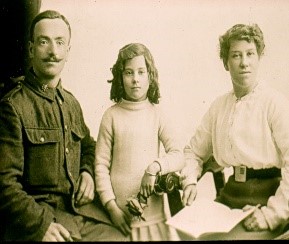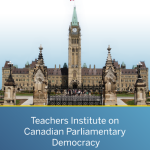
Come Walk Awhile in Our Shoes: A Journey of Ordinary – & Some Not-So-Ordinary -Canadians
By Peter Kear, BA (Hons), MEd, OCT
Peter Kear’s mother and grandparents, Kingston, Nov. 1914. Pte. Henry Herbert Goss was “killed in action” at the Ypres Salient, June 24, 1916.
My career as a secondary school history/civics teacher began the year after the Toronto Maple Leafs last won the Stanley Cup, and the year that Trudeaumania was sweeping across Canada.
1968 was also significant and controversial in Canadian history education. In that year, the National History Project in its publication, What Culture? What Heritage? A Study of Civic Education in Canada, stated that “Canadian history in our schools is a bland consensus story, told without the controversy that is an inherent part of history … a too-nice, straight forward, linear, dry-as-dust account of uninterrupted political and economic progress.”
To help address this perceived “bland consensus story” in history education – as well as in other subject areas – 1968 witnessed the publication in Ontario of the ideologically progressive Hall-Dennis Report, Living and Learning, that advocated scrapping a teacher-centred and rote-learning model of education for a more student-centred, inquiry-based curricula model.
Within this historical and pedagogical context, the idea of an in-class experiential approach for the teaching/learning of 20th century Canadian history took root and came to fruition during my MEd program in curriculum design at Queen’s University in the late 1970s.
Since then, the content of Come Walk Awhile in Our Shoes: A Journey of Ordinary – & Some Not-So-Ordinary – Canadians, 1900-45 & 1945-99 has been extensively expanded and has embraced digital technology. It has been endorsed by students, parents, teachers, history educators, and nationally-acclaimed historians.
In 2017, this innovative strategy is appropriately compliant with the strands, expectations, and the pedagogical thrust of the mandatory Grade 10 History program as prescribed within the 2013 Revised Ontario Canadian and World Studies curriculum document.
Come Walk Awhile in Our Shoes is a multi-perspective learning approach that takes history students on collective and individualized journeys through the impersonal macro-events (e.g. the so-called “Laurier boom years,” the First World War, the “Fabulous Fifties”), which shaped the Canadian experience during the 20th century.
At the beginning of the Grade 10 course, each student selects and assumes a personal profile that incorporates gender, ethnicity/ancestry, locality, and socioeconomic status. This personal profile provides each student with an unique identity lens that enables them to age and to vicariously experience the Canadian macro-events of the century. Students are “walking in the shoes” of their great-grandparents’ (1900-1945), and grandparents’ (1945-1999) generations.
The student personal profiles fall into two categories: ordinary Canadians, and not-so-ordinary Canadians. Some examples of ordinary Canadians from the 1900s include a Japanese fish cannery worker from Steveston, BC, a Sikh sawmill worker from Golden, BC; a Welsh miner and former Methodist chapel preacher, who is a labour organizer in the coalfields of the Crow’s Nest Pass, BC/AB; a German Mennonite immigrant from Czarist Russia, farming near Rosenfeld, MB; a recently-arrived Italian immigrant working in one of the largest tanneries in the British Empire, Huntsville, ON; an unemployed English abattoir worker from Peterborough, ON, who is severely depressed, the result of his recent experiences in the South African War; a terminally ill French-Canadian worker, who has contracted tuberculosis at a damp textile mill in Valleyfield, QC. Finally, an African Canadian, who is a coal-handler, toiling in the busy port of Halifax, NS.
Some examples of not-so-ordinary Canadians from the 1900s include Sir Henry Pellatt, Agnes Macphail, R.B. Bennett, Tim Buck, Adrien Arcand, Sir Clifford Sifton, Billy Bishop, Lawren Harris, William Hubbard, Francis Pegahmagabow, Nellie McClung, Moses Coady, Tomekichi Homma, Henri Bourassa, Mackenzie King, Emily Murphy, Norman Bethune, Fanny “Bobbie” Rosenfeld, Sir Joseph Flavelle, Lionel Conacher, Thérèse Casgrain, Arthur “Slim” Evans, William “Bible Bill” Aberhart, Mary Pickford, Sir Sam Hughes, Filip Konowal, J.S. Woodsworth, James Naismith, Aimee Semple McPherson, and Tom Longboat.
| “I find this approach draws students into Canadian history and increases their enjoyment of the subject; and that is a good thing in grade 10 Applied classes! Students often mention the roles they played in the simulation years later. What more could a history teacher ask of a simulation.” (Comment by teacher, Jim Fraser, Innisdale Secondary School, Barrie, ON, 22nd July 2002) |
Over one hundred personal profiles represent a diverse cross-section of backgrounds, interests and perspectives in Canadian society from the beginning of the last century. When students assume the identities of their personal profiles, they become the imaginary daughters/sons, the nieces/nephews, the siblings of these ordinary and not-so-ordinary Canadians.
| “The personal profile approach makes it more hands on and exciting. It makes you feel you were there in history, and that you would feel the suspense that you would feel it you were there. It was easy to remember when I used this learning approach.” (Comment by an Applied-level Grade 10 student at Huntsville High School, 27th June 2016) |
Students are confronted with specific dynamic situations within the historical context of the macro-events (e.g. the anti-Asiatic Vancouver riot of 1907 during the “Laurier boom years”), which impact their personal profiles’ lives and those of their families. Significantly, these dynamic situations can “hook” teenagers at both the cognitive (critical and historical thinking) and the affective levels of learning – so fundamental for sustained engaged learning.
Further, the dynamic situations involve “diverse perspectives,” along with the elements of uncertainty and unpredictability; hence they are problematic and controversial in nature. Significantly, the dynamic situations foster feelings and emotions appropriate to the specific historical settings. Four examples of these historically referenced dynamic situations from the 1920s and 1930s:
- With the 1919 dynamic situation, some “returned soldiers” from the Great War are physically and psychologically disabled; the resulting chronic health problems will affect their chances for stable employment. Depending on socioeconomic status, it may plunge their family down the social ladder.
- With the 1927 dynamic situation, depending on ethnicity/ancestry or socioeconomic status, some families experience xenophobic-based discrimination in the realms of housing and employment. A series of events, including the 1917 Bolshevik Revolution in Russia, the 1919 Winnipeg General Strike – and the resulting “Red Scare” – the passage of the 1923 federal Chinese Exclusion Act, and the rise of the KKK in certain regions of the country, have created and reflect an atmosphere of fear and intolerance in Canada during the “roaring twenties.”
- With the 1935 “New Deal” federal election dynamic situation, in the midst of the Great Depression, students express a political decision on the diverse variety of traditional and “protest” political parties from their personal profile For some ethnic and racial minorities – and the women of Quebec – there are still significant restrictions on voting rights.
| “Seeing historical events through your own eyes as they ‘happen’ to you makes them that much more memorable. I still remember things like my wife dying of the Spanish flu in 1918 and my [Japanese] friend being shipped off to New Denver in 1942.” (Comment by an Academic-level Grade 10 student, General Panet High School, Petawawa, ON, 17th June 2004) |
- With the 1939 dynamic situation, and based on their personal profiles, students write letters to their members of parliament expressing their support for – or opposition to – the federal government granting sanctuary to the Jewish refugees fleeing Nazi German aboard the ocean liner, S. St. Louis. Again, there remain significant restrictions on voting rights.
These personal profiles and dynamic situations provide a wealth of opportunities to illustrate the 2013 curriculum concepts of empathy, social justice, and significant “agents of change” within the Canadian narrative.
| “I would like to offer a strong letter of support for the work Peter Kear has done in his ‘Come Walk Awhile in Our Shoes’ program, or might I say, ‘experience.’ Experience is what my students – 58 teacher candidates had in my history methods course at OISE/UT. They and I would very much like to see Peter’s work expanded and supported” (Comment by John Myers, curriculum instructor, OISE/UT, 5th April 2004) |
Today, as in 1968, the crucial question remains: how can teachers in the present, authentically invite and capture the minds and hearts of adolescents – future citizens of our democratic society – in a critical and reflective study of Canada’s past that is informative, yet exciting?
If you wish a more detailed description of this learning strategy, or have comments, questions, please contact Peter at pkear@tyndale.ca, or go to his Facebook page at


